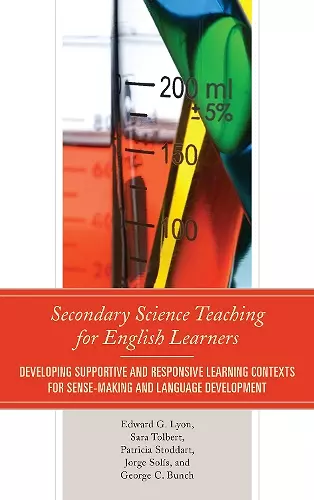Secondary Science Teaching for English Learners
Developing Supportive and Responsive Learning Contexts for Sense-Making and Language Development
Sara Tolbert author George C Bunch author Edward G Lyon author Jorge Solís author Patricia Stoddart author
Format:Hardback
Publisher:Rowman & Littlefield
Published:20th Jun '16
Currently unavailable, and unfortunately no date known when it will be back
This hardback is available in another edition too:
- Paperback£41.00(9781442231269)

Secondary Science Teaching for English Learners: Developing Supportive and Responsive Learning Context for Sense-making and Language Development provides a resource for multiple audiences, including pre- and in-service secondary science teachers, science teacher educators, instructional coaches, curriculum specialists, and administrators, to learn about a research-based approach to teaching science that responds to the growing population of English learners in the United States. The book offers clear definitions of pedagogical practices supported by classroom examples and a cohesive framework for teaching science in linguistically diverse classrooms. The Secondary Science Teaching with English Language and Literacy Acquisition (or SSTELLA) Framework addresses how learning science is enhanced through meaningful and relevant learning experiences that integrate discipline-specific literacy. In particular, four core science teaching practices are described: (1) contextualized science activity, (2) scientific sense-making through scientific and engineering practices, (3) scientific discourse, and (4) English language and disciplinary literacy development. These four core practices are supported by sound theory and research based on unscripted guidelines and flexible modifications of science lessons. Moreover, the four interrelated practices promote students’ use of core science ideas while reading, writing, talking, and doing science, thus reflecting principles from Next Generation Science Standards, Common Core State Standards for English Language Arts, and English language proficiency standards. Secondary Science Teaching provides readers with a historical and theoretical basis for integrating language, literacy, and science in multilingual science classrooms, and well as explicit models and guided support teachers in enacting effective teaching practices in the classroom, including comparative vignettes to distinguish between different types of classroom practice.
Teachers who work with English Language Learning (ELL) students have an excellent resource in the book Secondary Science Teaching for English Learners. This book provides strategies for helping their students make sense of science. One of the major challenges of teaching science to ELL students is helping them to understand science concepts while they are still developing their mastery of a new language. This book provides several examples of effective teaching strategies along with the research that validates each approach.... Secondary Science Teaching for English Learners is written for secondary science teachers and the ELL teachers who work collaboratively with them. The SSTELLA framework and the four practices that are highlighted provide a solid framework for teachers to create lessons that will help their students better understand challenging science concepts and thus prepare them for the future. * NSTA Recommends *
This book is a unique resource for science teachers who work with English Language Learners. Every chapter is filled with examples of effective classroom strategies for instruction and describes the supporting research in accessible ways. All of us who teach science in schools can learn from this text how to design units, scaffold instruction, and set up rich discourse environments that work for all students. -- Mark Windschitl, professor of Science Education, University of Washington
Those of us who work to provide content area support for secondary school English learners and their teachers have grown accustomed to the fact that there are few high quality, research-based resources available to aid us in meeting this challenge. Secondary Science Teaching for English Learners fills this need admirably, providing concrete strategies that are both theoretically grounded and practically tested in a range of secondary school classrooms. The SSTELLA Framework provides a clear blueprint for how language development and science learning can and must play synergistic roles in the secondary science classroom. -- Cory Buxton, Athletic Association Professor of Education, University of Georgia
Secondary Science Teaching for English Learners bridges the elusive gap between content and language instruction for English Learners in the critical content domain of science, addressing the intersections of curriculum, instruction and assessment. This is an important contribution for researchers, teacher educators, teachers, and policy makers. -- Eugene E. Garcia, professor emeritus, Arizona State University
A marvelous book providing real classroom examples of science, literacy and language instruction in action. The authors carefully construct theoretically sound and research based practices to help educators understand and deliver curriculum and instruction to teach and support all students’ engagement with scientific concepts and practices. Having read this book, I will immediately adopt it for my content area/disciplinary literacy classes and will encourage my science methods colleagues to do the same. This ground breaking work is a model for future projects that are desperately needed to make critical linkages between language, literacy and the disciplines. -- Patricia L. Anders, Jewell M. Lewis Distinguished Professor of Reading, Language, Reading and Culture Program, University of Arizona
ISBN: 9781442231252
Dimensions: 235mm x 161mm x 25mm
Weight: 572g
258 pages